The Incredible Story Behind the Film “The Eagle Huntress”
Documentary-maker Otto Bell’s debut feature tells the story of Aisholpan, a 13-year-old powerhouse bucking centuries of tradition with her quest to become modern-day Mongolia’s first prominent female eagle hunter.

Otto Bell was having an ordinary day perusing the BBC in his “cube” at an ad agency when he came across a series of photos so striking he actually stood up from his desk. “I thought, ‘Gosh, there’s got to be a film behind those photographs,’” he recalled of the images, which featured a girl, her father, and an eagle against the desolate landscape of Mongolia.
So, like any aspiring documentary filmmaker would do, he Facebook-stalked the photographer, Asher Svidensky, and soon learned that the girl in question was named Aisholpan Nurgaiv. At just 13, she was already determined to become the first woman in her family’s 12 generations of eagle hunters — an aspiration that was not only ruffling feathers in her community, but outright offending its most prominent members, as Bell quickly discovered on his impromptu trip to the Altai mountains to meet her face-to-face.
As it turned out, he’d arrived just in the nick of time: Visitors aren’t exactly common in the most remote part of the least populated country in the world, and Aisholpan’s father welcomed Bell and his tiny crew with open arms — starting with inviting them along on his and Aisholpan’s trip to nab an eaglet of her own that very afternoon, a risky occasion for which there’s only a tiny window every year. Before he knew it, Bell was shooting footage for what would be his first feature film, while scaling a steep rocky cliff in nearly subzero temperatures, even if Aisholpan, with a rope tied around her waist and an eye on the massive mother bird circling above, somehow seemed to navigate with ease.
Bell and his three-member crew had a little more notice with their next seven trips to Mongolia, meaning they could bring along equipment that would do justice to the landscape, like drones to capture a bird’s-eye view. There were months of training, plus the Gold Eagle Festival, the Kazakh eagle-hunting contest which Aisholpan was the first-ever woman to enter, and there was the matter of finding gear that had the best chance of surviving the minus 50-degree weather up in the mountains where Aisholpan roamed for over 20 days to prove herself by capturing a fox. (They never exactly cracked that one, instead shooting only during the strongest two hours of sun every day.)
Behind the Scenes of “The Eagle Huntress” in the Most Desolate Regions of Mongolia
Aisholpan’s father, Nurgaiv.
Aisholpan’s father, Nurgaiv, and Aisholpan.
Aisholpan.
Aisholpan and her father, Nurgaiv.
Aisholpan and her father, Nurgaiv.
Aisholpan’s father, Nurgaiv.
Some of the film’s most striking scenes, though, are the least high tech: Bell’s interviews with elders in the Kazakh community whose blood seems to boil at the very mention of Aisholpan’s ambitions — and women’s place in anything other than the home, especially when it comes to centuries-long traditions — leave just as lasting an impression as the film’s breathtaking views. Each is decked out in the furs they’ve amassed from their various hunts, which serve as far more than armor against the bitter winters: “The more elaborate your furs are, the greater an eagle hunter you are perceived to be,” Bell explained. “So costumes have a societal importance and are very much intertwined with their machismo and masculinity.”
Those scenes are just one aspect of what makes the film, and Aisholpan’s mission, so empowering. It’s a message that Bell is especially eager to get out now “with all this poisonous locker room talk,” but which of course has resonated long before the election, too. Even someone as familiar with epics as Daisy Ridley, who narrated the film, was so moved by an earlier version of it that she called Bell the night before it premiered at Sundance to ask how she could help. The documentary filmmaker Morgan Spurlock, who came on as a producer, had the same reaction, and he soon brought Sia onboard to put together a theme song “so pitch perfect for the film” that the first time Spurlock played it for him, Bell recalled, they both sat in his office and cried their eyes out.
The film hits theaters November 2, though it’s already seeing real implications back home in the steppe: three other girls signed up to compete in this year’s festival, and Aisholpan, now 15, has since won a scholarship to one of the country’s best schools, where she’s gearing up to be a surgeon (with funds raised from the film). That’s on the weekdays, though. The weekends are still reserved for spending time with her bird.